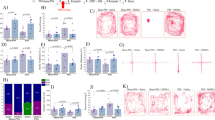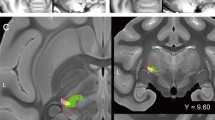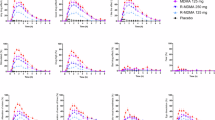Abstract
Six rhesus monkeys were trained to stable performance on neuropsychological tests of memory, reinforcer efficacy, reaction time and bimanual motor coordination. Three monkeys were then exposed to a high-dose, short course regimen of (±)3,4-Methylenedioxymethamphetamine (MDMA, “Ecstasy”) (4 days, 10 mg/kg i.m., b.i.d.). Following treatment, concentrations of 5-hydroxyindoleacetic acid (5-HIAA) in cerebrospinal fluid (CSF) were reduced by ∼50% in the treated animals, and this effect persisted for approximately three months post-MDMA. Behavioral performance was disrupted during acute MDMA treatment but returned to baseline within one week following treatment. MDMA also produced persistent alterations in late peak latencies of brainstem auditory evoked potentials (BSAEP), lasting three months post-MDMA. Both CSF 5-HIAA concentrations and evoked potential latencies were normalized four months after treatment. These findings indicate that serotonergic alterations associated with MDMA use may result in persisting changes in brain function.
Similar content being viewed by others
Log in or create a free account to read this content
Gain free access to this article, as well as selected content from this journal and more on nature.com
or
References
Aguirre N, Galbete JL, Lasheras B, Del Rio J . (1995): Methylenedioxymethamphetamine induces opposite changes in central pre- and post-synaptic 5-HT1A receptors in rats. Eur J Pharmacol 281: 101–105
Ali SF, Newport GD, Scallet AC, Binienda Z, Ferguson SA, Bailey JR, Paule MG, Slikker W Jr . (1993): Oral administration of 3,4-methylenedioxymethamphetamine (MDMA) produces selective serotonergic depletion in the nonhuman primate. Neurotoxicol Teratol 15: 91–96
Bolla KI, McCann UD, Ricaurte GA . (1998): Memory impairment in abstinent MDMA (“Ecstasy”) users. Neurology 51: 1532–1537
Curran HV, Travill RA . (1997): Mood and cognitive effects of +/-3,4-methylenedioxymethamphetamine (MDMA, ‘ecstasy’): week-end ‘high’ followed by mid-week low. Addiction 92: 821–831
Dafters RI, Duffy F, O'Donnell PJ, Bouquet C . (1999): Level of use of 3,4-methylenedioxymethamphetamine (MDMA or Ecstasy) in humans correlates with EEG power and coherence. Psychopharmacology (Berl) 145: 82–90
Fischer C, Hatzidimitriou G, Wlos J, Katz J, Ricaurte G . (1995): Reorganization of ascending 5-HT axon projections in animals previously exposed to the recreational drug (+/-)3,4-methylenedioxymethamphetamine (MDMA, “ecstasy”). J Neurosci 15: 5476–5485
Frederick DL, Ali SF, Gillam MP, Gossett J, Slikker W, Paule MG . (1998): Acute effects of dexfenfluramine (d-FEN) and methylenedioxymethamphetamine (MDMA) before and after short-course, high-dose treatment. Ann N Y Acad Sci 844: 183–190
Frederick DL, Ali SF, Slikker W, Gillam MP, Allen RR, Paule MG . (1995): Behavioral and neurochemical effects of chronic methylenedioxymethamphetamine (MDMA) treatment in rhesus monkeys. Neurotoxicol Teratol 17: 531–543
Gamma A, Frei E, Lehmann D, Pascual-Marqui RD, Hell D, Vollenweider FX . (2000): Mood state and brain electric activity in ecstasy users. Neuroreport 11: 157–162
Hatzidimitriou G, McCann UD, Ricaurte GA . (1999): Altered serotonin innervation patterns in the forebrain of monkeys treated with (+/-)3,4-methylenedioxymethamphetamine seven years previously: factors influencing abnormal recovery. J Neurosci 19: 5096–5107
Insel TR, Battaglia G, Johannessen JN, Marra S, De Souza EB . (1989): 3,4-Methylenedioxymethamphetamine (“ecstasy”) selectively destroys brain serotonin terminals in rhesus monkeys. J Pharmacol Exp Ther 249: 713–720
Krystal JH, Price LH, Opsahl C, Ricaurte GA, Heninger GR . (1992): Chronic 3,4-methylenedioxymethamphetamine (MDMA) use: effects on mood and neuropsychological function?. Am J Drug Alcohol Abuse 18: 331–341
Li AA, Marek GJ, Vosmer G, Seiden LS . (1989): Long-term central 5-HT depletions resulting from repeated administration of MDMA enhances the effects of single administration of MDMA on schedule-controlled behavior of rats. Pharmacol Biochem Behav 33: 641–6648
McCann UD, Ridenour A, Shaham Y, Ricaurte GA . (1994): Serotonin neurotoxicity after (+/-)3,4-methylenedioxymethamphetamine (MDMA; “Ecstasy”): a controlled study in humans. Neuropsychopharmacology 10: 129–138
McCann UD, Szabo Z, Scheffel U, Dannals RF, Ricaurte GA . (1998): Positron emission tomographic evidence of toxic effect of MDMA (“Ecstasy”) on brain serotonin neurons in human beings. Lancet 352: 1433–1437
McKenna DJ, Peroutka SJ . (1990): Neurochemistry and neurotoxicity of 3,4-methylenedioxymethamphetamine (MDMA, “ecstasy”). J Neurochem 54: 14–22
Morgan MJ . (1998): Recreational use of “ecstasy” (MDMA) is associated with elevated impulsivity. Neuropsychopharmacology 19: 252–264
Morgan MJ . (1999): Memory deficits associated with recreational use of “ecstasy” (MDMA). Psychopharmacology (Berl) 141: 30–36
Obrocki J, Buchert R, Vaterlein O, Thomasius R, Beyer W, Schiemann T . (1999): Ecstasy–long-term effects on the human central nervous system revealed by positron emission tomography. Br J Psychiatry 175: 186–188
Park SB, Coull JT, McShane RH, Young AH, Sahakian BJ, Robbins TW, Cowen PJ . (1994): Tryptophan depletion in normal volunteers produces selective impairments in learning and memory. Neuropharmacology 33: 575–588
Parrott AC, Lasky J . (1998): Ecstasy (MDMA) effects upon mood and cognition: before, during and after a Saturday night dance. Psychopharmacology (Berl) 139: 261–268
Parrott AC, Lees A, Garnham NJ, Jones M, Wesnes K . (1998): Cognitive performance in recreational users of MDMA of 'ecstasy': evidence for memory deficits. J Psychopharmacol 12: 79–83
Peroutka SJ . (1987): Incidence of recreational use of 3,4-methylenedimethoxymethamphetamine (MDMA, “ecstasy”) on an undergraduate campus. N Engl J Med 317: 1542–1543[letter]
Prospero-Garcia O, Gold LH, Fox HS, Polis I, Koob GF, Bloom FE, Henriksen SJ . (1996): Microglia-passaged simian immunodeficiency virus induces neurophysiological abnormalities in monkeys. Proc Natl Acad Sci U S A 93: 14158–14163
Ricaurte GA, DeLanney LE, Irwin I, Langston JW . (1988a): Toxic effects of MDMA on central serotonergic neurons in the primate:importance of route and frequency of drug administration. Brain Res 446: 165–168
Ricaurte GA, DeLanney LE, Wiener SG, Irwin I, Langston JW . (1988b): 5-Hydroxyindoleacetic acid in cerebrospinal fluid reflects serotonergic damage induced by 3,4-methylenedioxymethamphetamine in CNS of non-human primates. Brain Res 474: 359–363
Ricaurte GA, Forno LS, Wilson MA, DeLanney LE, Irwin I, Molliver ME, Langston JW . (1988c): (+/-)3,4-Methylenedioxymethamphetamine selectively damages central serotonergic neurons in nonhuman primates. JAMA 260: 51–55
Ricaurte GA, Martello AL, Katz JL, Martello MB . (1992): Lasting effects of (+-)-3,4-methylenedioxymethamphetamine (MDMA) on central serotonergic neurons in nonhuman primates: neurochemical observations. J Pharmacol Exp Ther 261: 616–622
Scheffel U, Szabo Z, Mathews WB, Finley PA, Dannals RF, Ravert HT, Szabo K, Yuan J, Ricaurte GA . (1998): In vivo detection of short- and long-term MDMA neurotoxicity–a positron emission tomography study in the living baboon brain. Synapse 29: 183–192
Schuster P, Lieb R, Lamertz C, Wittchen HU . (1998): Is the use of ecstasy and hallucinogens increasing? Results from a community study. Eur Addict Res 4: 75–82
Semple DM, Ebmeier KP, Glabus MF, O'Carroll RE, Johnstone EC . (1999): Reduced in vivo binding to the serotonin transporter in the cerebral cortex of MDMA (‘ecstasy’) users. Br J Psychiatry 175: 63–69
Steele TD, McCann UD, Ricaurte GA . (1994): 3,4-Methylenedioxymethamphetamine (MDMA, “Ecstasy”): pharmacology and toxicology in animals and humans. Addiction 89: 539–551
Taffe MA, Weed MR, Gold LH . (1999): Scopolamine alters rhesus monkey performance on a novel neuropsychological testing battery. Cogn Brain Res 8: 203–212
Thompson AM, Moore KR, Thompson GC . (1995): Distribution and origin of serotoninergic afferents to guinea pig cochlear nucleus. J Comp Neurol 351: 104–116
Thompson AM, Thompson GC . (1995): Light microscopic evidence of serotoninergic projections to olivocochlear neurons in the bush baby (Otolemur garnettii). Brain Res 695: 263–266
Thompson GC, Thompson AM . (1986): Olivocochlear neurons in the squirrel monkey brainstem. J Comp Neurol 254: 246–258
Thompson GC, Thompson AM, Garrett KM, Britton BH . (1994): Serotonin and serotonin receptors in the central auditory system. Otolaryngol Head Neck Surg 110: 93–102
Vollenweider FX, Gamma A, Liechti M, Huber T . (1998): Psychological and cardiovascular effects and short-term sequelae of MDMA (“ecstasy”) in MDMA-naive healthy volunteers. Neuropsychopharmacology 19: 241–251
Weed MR, Gold LH . (1998): The effects of dopaminergic agents on reaction time in rhesus monkeys. Psychopharmacology (Berl) 137: 33–42
Weed MR, Taffe MA, Polis I, Roberts AC, Robbins TW, Koob GF, Bloom FE, Gold LH . (1999): Performance norms for a rhesus monkey neuropsychological testing battery: Acquisition and long-term performance. Cogn Brain Res 8: 184–201
Yeh SY . (1999): N-tert-butyl-alpha-phenylnitrone protects against 3,4- methylenedioxymethamphetamine-induced depletion of serotonin in rats. Synapse 31: 169–177
Acknowledgements
Supported by USPHS grants: MH19185 (MAT), DA05831 (MRW), DA11004 (LHP), MH47680 (SJH, SH-R) and DA09111 (LHG). This is publication #13142-NP from The Scripps Research Institute.
Author information
Authors and Affiliations
Corresponding author
Rights and permissions
About this article
Cite this article
Taffe, M., Weed, M., Davis, S. et al. Functional Consequences of Repeated (±)3,4-Methylenedioxymethamphetamine (MDMA) Treatment in Rhesus Monkeys. Neuropsychopharmacol 24, 230–239 (2001). https://doi.org/10.1016/S0893-133X(00)00185-8
Received:
Revised:
Accepted:
Issue date:
DOI: https://doi.org/10.1016/S0893-133X(00)00185-8
Keywords
This article is cited by
-
The Use of Touchscreen-Based Methods to Characterize Effects of Psychoactive Drugs on Executive Function in Nonhuman Primates
Current Pharmacology Reports (2023)
-
Effects of prior cocaine self-administration on cognitive performance in female cynomolgus monkeys
Psychopharmacology (2015)
-
Human Ecstasy Use is Associated with Increased Cortical Excitability: An fMRI Study
Neuropsychopharmacology (2011)
-
Interactions between ethanol and cocaine, amphetamine, or MDMA in the rat: thermoregulatory and locomotor effects
Psychopharmacology (2008)
-
MDMA modifies active avoidance learning and recall in mice
Psychopharmacology (2008)



